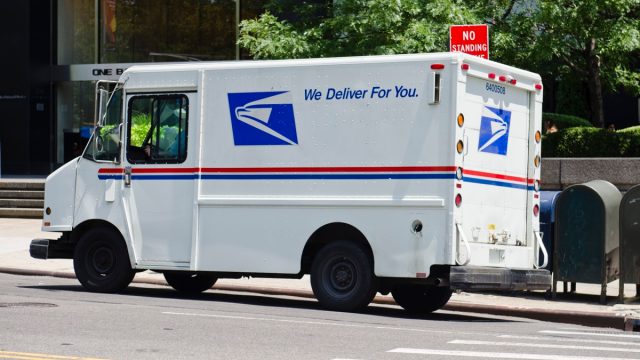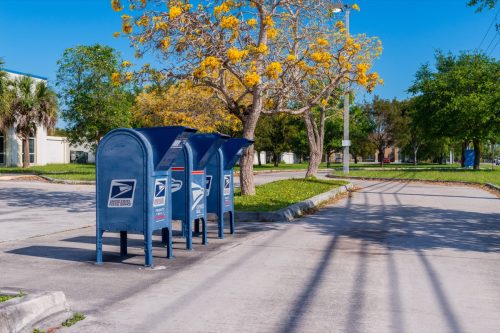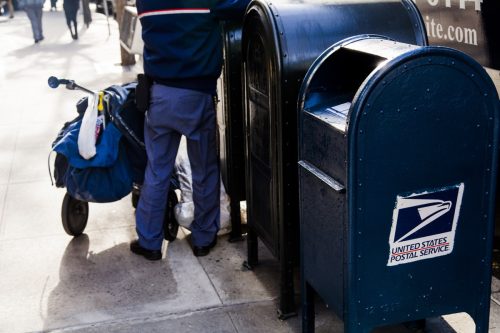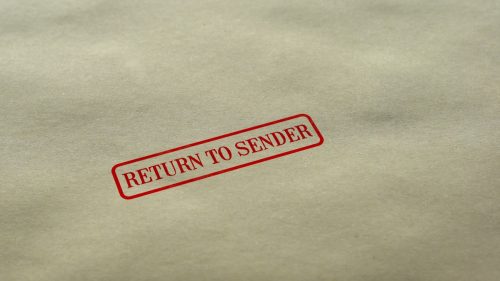USPS Warns You Not to Drop This Kind of Mail in a Mailbox

There are a number of ways you can send mail through the U.S. Postal Service’s (USPS) system, whether you’re stopping by your local post office or sticking it in your mailbox with the flag up. But many of us just rely on the agency’s iconic blue collection boxes to drop off mail. If that’s your M.O., you might be distressed to learn that they could soon be a thing of the past. According to Linn’s Stamp News, the number of these mailboxes has been dwindling, with USPS spokeswoman Kimberly A. Frum telling the magazine that there were just 147,000 blue collection boxes left as of May 2021.
For now, however, you can still use those mailboxes with ease—but that doesn’t mean you can put just anything in there. In fact, many people don’t realize what’s restricted from collection boxes, and could end up paying the price. Read on to find out what the USPS is warning you not to drop in its blue boxes.
READ THIS NEXT: USPS Is Making This Unprecedented Change to Service, Starting June 20.
The USPS has faced recent concerns over its collection boxes.

The dwindling number of blue collection boxes is not the only problem the USPS is facing with its mailboxes. Last month, four U.S. senators sent a letter to U.S. Postmaster General Louis DeJoy, slamming the Postal Service for concerns over rising instances of mail theft occurring with these mailboxes.
“Reports that thieves are accessing USPS Blue Collection boxes to steal and then sort through mail to identify checks that they then use for personal gain are deeply troubling,” the senators wrote in their letter. “Americans use the Postal Service to mail checks to pay their taxes and bills; they should not have to worry that those checks may be stolen.”
But thievery aside, there are drawbacks to these mailboxes that people should be aware of.
There are some types of mail you can’t put in these mailboxes.

According to the USPS, there are actually restrictions on what can be deposited in its collection boxes when it comes to size. The Postal Service says that any mail that weighs over 10 ounces or is more than a half-inch in thickness is “not allowed” in the blue collection boxes, unless it has postage from a postage meter strip.
Per the agency, postage meters print postage directly onto mailpieces or onto meter tape and are leased by authorized providers for use in your home or office. “To use a Postage Meter, you must obtain a permit to do so in the city of mailing,” the USPS explains.
The average person sending mail will need to be aware of the restriction: Both domestic or international mail that is only marked with postage stamps must weigh 10 ounces or less or be less than one-half inch in thickness in order to be shipped using a collection box.
RELATED: For more up-to-date information, sign up for our daily newsletter.
Your mail could get returned to you if you don’t send it correctly.

The USPS says that “all mailpieces that are not acceptable for deposit in a collection box” must be taken to the post office for processing. But don’t try tossing these into a self-service dropbox in the lobby of the post office either. If you have mail that weighs more than 10 ounces or measures more than a half-inch in thickness with only postage stamps, it “must be brought to an employee at a retail counter in a Post Office,” the Postal Service says. And for those who ignore this restriction, “mail deposited incorrectly will be ‘Returned to Sender’ for proper deposit,” the agency notes.
Overall, if you’re not sure if your mail can go in a collection box or if you find that it’s hard to fit your shipment in one of these boxes, you might want to bring it to the post office just in case. “Customers should never try to force their packages into a collection box,” Frum recently told eCommercebytes.com. “Rather they should take the packages to their local Post Office for mailing.”
There are others reasons your mail might get returned to you.

Sending your mail off the right way is obviously a major factor in making sure it gets where it’s supposed to, but there are lots of other reasons it could end up sent back to you. According to the USPS, any mail without enough postage or mail that doesn’t include a full or accurate delivery address is likely to be returned to the sender. You won’t even know this has happened until it arrives back at your home, as the agency says it “cannot provide a notification if a mailpiece you sent is returned to sender.”
And even if you fix the issue, your mail could be returned to you again if you don’t use a new envelope. According to the Postal Service, a “Return to Sender” mark is usually “very prominent and is designed to be eye-catching.” Since postal workers and postal equipment usually only have a few seconds to look at a piece of mail before sending it through, they may end up incorrectly processing it if that mark is still there.
“For this reason, we ask that any returned mail, upon being mailed again, be enclosed in a separate (new) envelope with new postage to ensure prompt processing. This also helps to avoid mail being returned to the sender a second time,” the USPS warns.